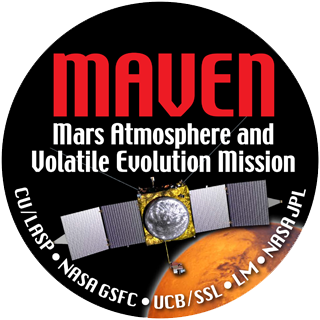
Currently available data extend through February 14, 2025 (Ls 43.8, MY 38) [ongoing]
(MAVEN Mars orbit insertion occurred Sep 21, 2014; Ls 199.8, MY 32)
(MAVEN Mars orbit insertion occurred Sep 21, 2014; Ls 199.8, MY 32)
The Disk Mode
Software Interface Specification (SIS) - Description of the instrument and data structures
Raw Data The files will contain both images and tables. Many fields are direct unconverted copies of telemetry produced by the instrument. The units for such fields, data numbers (DN), may represent ADC counts, encoder steps, discrete time intervals, and so on. See the SIS section 6.1.1.Table 18: Raw data file structure.
Calibrated Data The files are similar in structure to the raw products but they are expressed as spectral radiance in units of kilorayleighs/nm. Estimates of uncertainty are included. See the SIS section 6.1.2 Table 19: Calibrated data file structure.
Processed Data
Processed data are stored as FITS files with detached XML labels and are calibrated data that have been reduced by isolating emission features and implementing spatial binning to facilitate processing. See the SIS section 6.1.3 Table 22: Disk processed data file structure.
Derived Data
IUVS data files are stored as FITS files with detached XML labels and contain derived densities and column abundances at the native geometry of the observation and/or on a regular grid in altitude or latitude and longitude, as appropriate. For mid UV and far UV see the SIS section 6.1.4 Table 26: Disk MUV derived data file structure and Table 27: Disk FUV derived data file structure.
Retrieving Data
The MAVEN/IUVS data are in FITS format with detached XML labels (Need to acquire a FITS reader?)
Selected data can be retrieved in 2 ways
Downloading annual collections of data
2014 calibrated (2.6 GB) 2014 processed (378 MB) 2014 derived (20.8 MB)
2015 calibrated (30.3 GB) 2015 processed (5.2 GB) 2015 derived (141 MB)
2016 calibrated (203 GB) 2016 processed (3.6 GB) 2016 derived (88.1 MB)
2017 calibrated (84.8 GB)
2018 calibrated (287 GB)
2019 calibrated (173 GB)
2020 calibrated (334 GB)
2021 calibrated (179 GB)
2022 calibrated (245 GB)
2023 calibrated (186 GB)
2024 calibrated (245 GB)
2025 calibrated (116 GB)
Raw Data is included in the complete collection.
Citing Data Sets for Publications
Use of calibrated data
Schneider, N. et al., MAVEN IUVS Calibrated-level Data Product Bundle,
urn:nasa:pds:maven.iuvs.calibrated, 2015.
Use of processed data
Schneider, N. et al., MAVEN IUVS Processed-level Data Product Bundle,
urn:nasa:pds:maven.iuvs.processed 2015.
Use of derived data
Schneider, N. et al., MAVEN IUVS Derived-level Data Product Bundle,
urn:nasa:pds:maven.iuvs.processed 2015.
Processed data are stored as FITS files with detached XML labels and are calibrated data that have been reduced by isolating emission features and implementing spatial binning to facilitate processing. See the SIS section 6.1.3 Table 22: Disk processed data file structure.
Derived Data
IUVS data files are stored as FITS files with detached XML labels and contain derived densities and column abundances at the native geometry of the observation and/or on a regular grid in altitude or latitude and longitude, as appropriate. For mid UV and far UV see the SIS section 6.1.4 Table 26: Disk MUV derived data file structure and Table 27: Disk FUV derived data file structure.
Retrieving Data
The MAVEN/IUVS data are in FITS format with detached XML labels (Need to acquire a FITS reader?)
Selected data can be retrieved in 2 ways
1) Downloading an index, selecting components and uploading your selection.
Indices that tabulate information associated with each product are available. The associated geometry is for the subspacecraft point and for the time of the midpoint of the observation.
2) Selecting specific parameters and requesting limited data files
Indices that tabulate information associated with each product are available. The associated geometry is for the subspacecraft point and for the time of the midpoint of the observation.
a. Select your index
Calibrated Disk index (Downloadable csv file) before 2019-06-20
Calibrated Disk index (Downloadable csv file) after 2019-06-20
Processed (csv) No data after 2016-04-05
Derived Data (csv) Note the caveats No data after 2016-04-05
Calibrated Disk index (Downloadable csv file) after 2019-06-20
Processed (csv) No data after 2016-04-05
Derived Data (csv) Note the caveats No data after 2016-04-05
b. Sort and make your selection
c. Upload the URN values from your revised index (note the total uncompressed file size before requesting)
c. Upload the URN values from your revised index (note the total uncompressed file size before requesting)
2) Selecting specific parameters and requesting limited data files
Downloading annual collections of data
2014 calibrated (2.6 GB) 2014 processed (378 MB) 2014 derived (20.8 MB)
2015 calibrated (30.3 GB) 2015 processed (5.2 GB) 2015 derived (141 MB)
2016 calibrated (203 GB) 2016 processed (3.6 GB) 2016 derived (88.1 MB)
2017 calibrated (84.8 GB)
2018 calibrated (287 GB)
2019 calibrated (173 GB)
2020 calibrated (334 GB)
2021 calibrated (179 GB)
2022 calibrated (245 GB)
2023 calibrated (186 GB)
2024 calibrated (245 GB)
2025 calibrated (116 GB)
Raw Data is included in the complete collection.
Citing Data Sets for Publications
Use of calibrated data
Schneider, N. et al., MAVEN IUVS Calibrated-level Data Product Bundle,
urn:nasa:pds:maven.iuvs.calibrated, 2015.
Use of processed data
Schneider, N. et al., MAVEN IUVS Processed-level Data Product Bundle,
urn:nasa:pds:maven.iuvs.processed 2015.
Use of derived data
Schneider, N. et al., MAVEN IUVS Derived-level Data Product Bundle,
urn:nasa:pds:maven.iuvs.processed 2015.
 PDS: The Planetary Atmospheres Node
PDS: The Planetary Atmospheres Node


